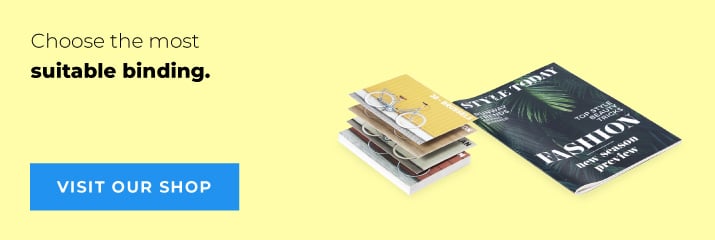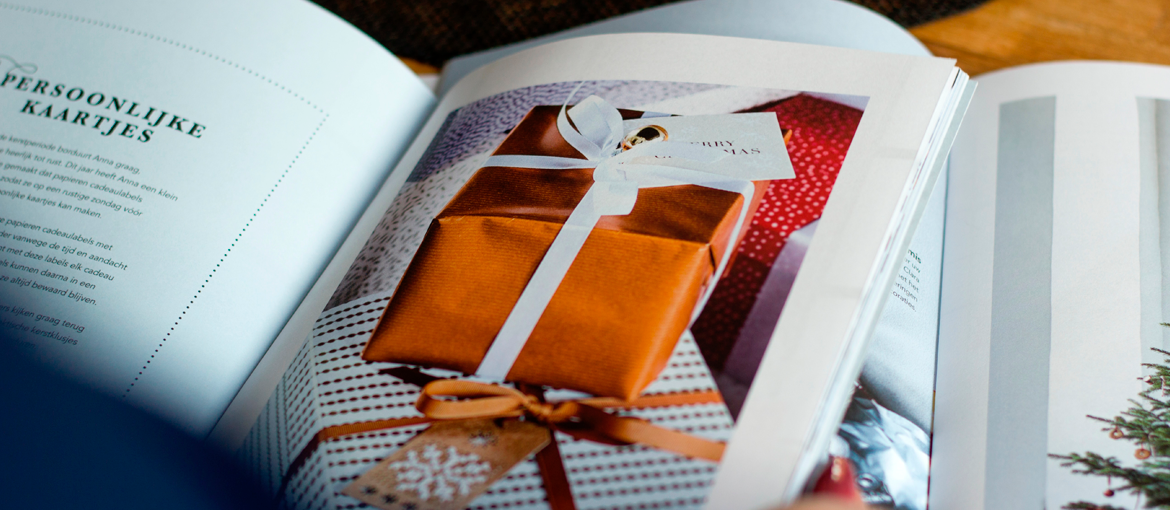Table of Contents
Need to print a book, a catalogue or a magazine but don’t know what binding to choose? Well, you’re in the right place! In this article, we explain the meaning of perfect binding and sewn binding – the two most commonly used techniques for binding books.
Soft binding, perfect binding, sewn binding… For those who aren’t industry experts, these terms can rightly cause a bit of confusion. Which is why we’re going to explain them to you as simply as possible, while covering the following:
- what soft binding means
- what perfect binding means and its features
- what sewn binding means and its features
- which binding you should choose for the publication that you want to print
Once you’ve read the article, we’re confident that you’ll know which type of binding is best for your publication. Ready? Off we go! First things first: what is a soft-bound book?
First things first: what is a soft-bound book?
Let’s start by explaining what soft binding means. Soft binding is a type of binding used to create paperback books by joining the cover – usually made of paper or card – to the “gathering” or “signature”, in other words, the sheets that make up the publication.
Like any type of binding, soft binding does not just hold together your printed pages, but gives shape to the publication, ensures it lasts over time and makes it easy to use for the reader. Now we’ve clarified what a soft-bound book is, we should say that there are different types of soft binding: perfect binding, sewn binding, staple binding and wire-o binding.
The difference between these types of binding lies in the way that the sheets are processed and joined to the cover once they’re been printed. Simply put:
- When the sheets are glued directly to the cover, we call this perfect binding
- When the sheets are first sewn together with thread and then glued to the cover, we call this sewn binding
- When metal staples are used to join the sheets to the cover, we call this staple binding
- When rings are used to join the sheets to the cover, we call this wire-o binding

Two types of binding for your books: perfect and sewn
We’ve already seen what soft binding means and the different types of soft binding. In this article, however, we want to concentrate on the meaning of perfect binding and sewn binding: these are the two most commonly used types of soft binding.
Remember: if you want to bind a book or any other publication with more than 50 pages and present it to the public in an attractive and professional guise, then you should use one of these types of binding.
What is perfect binding?
Perfect binding is one of the techniques most often used to bind books. It’s fast, cheap and typically recommended for books with up to 150 pages.
Perfect binding involves gluing a card cover to the spine of the publication. Before gluing, however, the “gathering” – in other words, the sheets of the publication that have been folded into 4, 8, 16 or 32 pages – are milled on the side where the cover will be glued. There are two types of preparation in this process: the sheets can be trimmed or notched.
The goal is simple: to roughen up the spine so that the glue can more easily penetrate the material, resulting in a more durable binding.
In the Pixartprinting catalogue, you can choose different types of paper for your perfect bound publication. An ideal paper for this type of binding is one that is lightweight and porous (you’ll find our guide to the most common paper types here).
What is sewn binding?
Sewn binding is a more advanced binding method than perfect binding because it requires an extra step: the gatherings – or the pages of your publication – are sewn together into single block before being glued to the cover.
They are sewn using cotton, hemp, linen or synthetic thread. Sewing ensures better hold over time and greater resistance to wear than perfect binding. However, sewn binding is more expensive and takes longer.
![Una brossura cucita a filo refe. Immagine: flickr/Horia Varlan [CC BY 2.0]](https://www.pixartprinting.it/blog/wp-content/uploads/2020/01/significato_filo_refe.jpg)
Like perfect binding, the gatherings are glued to the cover. But before gluing, they are sewn together. When to choose perfect binding
When to choose perfect binding
We recommend choosing perfect binding if your publication has fewer than 150 pages, if you have a small budget and if you want to quickly bind your work.
Books are the most common application for this type of binding. You can consider it if you are thinking about printing:
- Textbooks
- Brochures with a lot of content
- riviste
- Dissertations
- catalogues
This type of binding is a cheap and fast option – Pixartprinting offers online printing and perfect binding in 24-48 hours.
 When to choose sewn binding
When to choose sewn binding
We recommend choosing sewn binding if your publication has more than 150 pages, if you have a bigger budget or if you want produce a smarter-looking product.
Compared to perfect binding, sewn binding is definitely more professional, particularly if you have readers who will appreciate the craftsmanship. Which is why it’s the most suitable binding technique if you want to produce:
- A premium book
- An illustrator’s sketchbook
- A graphic designer’s portfolio
- A particularly hefty company catalogue
- A graphic novel
Compared to other binding methods, however, production times are longer. Pixartprinting offers 7-day delivery for products with sewn binding.
What method will you use to bind your next publication? Sewn or perfect binding?

